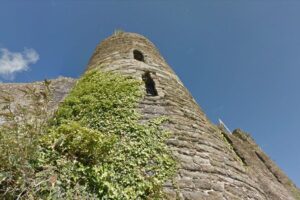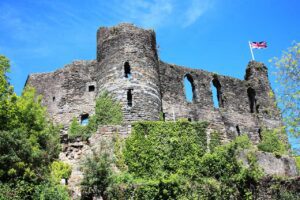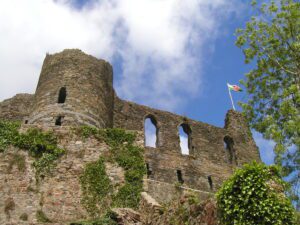Haverfordwest Castle
The current site of the castle was chosen not just for a marvellously defensive position over the town and Western Cleddau River but also because the existing fortified banks and ditches could be renovated and included in the castle. Unfortunately the castle now obscures all traces of Iron Age remains.
The castle was originally built by Tancred the Fleming around 1110.Originally it would have been a wooden motte and bailey or ringwork design castle. Also due to hostilities it would have been assembled very quickly and hastily. The original medieval town would therefore have been established at around the same time and would have been Flemish not Norman. In fact it was probably the main area of Flemish settlement in Pembrokeshire. The Flemish settled here around 1108, protecting the main Norman stronghold at Pembroke from Welsh attacks generating from the north.
Tancred`s family retained the castle until 1210.
As this stretch of the Cleddau is tidal, Haverfordwest has access to the sea, vital for communications in an often hostile country and developed as a port.
The castle appears to have resisted Welsh attempts to storm it in the fighting with Gruffydd ap Rhys , Prince of Deheubarth (1135 to 1136).
Following the building of the castle on the northern and western slopes, near castle gate, currently Queens Square, Hayguard Lane and St Martin’s Church, the town started to develop. Originally there would have been timber town walls, possibly following wear and tear these would have been replaced in the thirteenth century by stone walls. But by 1640 s and the time of the Civil Wars even the stone walls were derelict. Now hardly any remain. The town gates were demolished in the 1760’s.
NOTABLE DATES IN THE CASTLE AND TOWN HISTORY
• 1171 – Henry the Second visited on his return journey from Ireland.
• 1188 – Whilst progressing and preaching around Wales, drumming up support for the 3rd crusade , Gerald Cambrensis visited.
• 1200 – By now the Castle `s rectangular north eastern tower is reconstructed in stone, as the Keep.
• 1210 – The town’s Augustinian Priory has been founded.
• 1210 – As well as making several visits here, on his way to Ireland, King John removes the castle from Robert Fitz Richard into royal control.
• 1213 – The castle is granted to the wealthy and powerful William Marshal, Earl of Pembroke by King John. Doubtless in return for a substantial sum of money. As William Marshal was, at this time, rebuilding Pembroke castle in stone, it is logical to assume that he would also do the same, at the same time, with Haverfordwest Castle.
• 1217 – The Prince of Gwynedd, Llywelyn the Great ( Llywelyn ap Iorwerth) threatened but did not attack the town.
• 1220 – Llywelyn attacks and burns the town but fails to storm the castle.
• 1246 – A Dominican Friary established.
• 1248 – The castle is acquired by Humphrey de Bohun the Second of the powerful marcher family.
• 1257 – The Prince of Gwynedd, later to be Prince of wales , Llywelyn the Last (Llywelyn ap Gruffydd ) attacks Haverfordwest. But is resisted.
• 1265 – William de Valance, Earl of Pembroke captured the castle during the Barons War.
• 1274 – The Crown granted the castle to Humphrey de Bohun the Third.
• 1284 – Edward the First and Queen Eleanor visit on a royal pilgrimage to St David`s.
• 1289 – Queen Eleanor acquires the castle from Humphrey de Bohun the third. She spent £407 on improvements, the final major medieval building phase, constructing extensive stone buildings to the south and east of the inner ward. Eleanor died in 1290, possibly never having completed the renovations. The ruins of today’s castle date from this period. From this date the castle had various tenants but remained in Royal hands.
• 1349 – there was a major loss of population and resulting economic decline following an outbreak of Black Death.
• 1394 -1399 – Three visits from Richard the Second resulting in parts of the castle being rebuilt.
• 1405 – Owain Glyndwr and his Franco Welsh forces burn Haverfordwest but fail to capture the castle. Even so the castle was further strengthened with a new tower.
• 1479 – A Royal Charter granting Haverfordwest status as both town and county is made.
• 1485 – Before his victory at Bosworth and subsequent crowning as Henry the Seventh, Henry, Earl of Richmond visits the town.
• 1532 – Anne Boleyn is granted the castle by Henry the Eighth. She kept it until her death, by beheading in 1536.
• 1543 – The Second Act of Union confirms Haverfordwest as both a town and county in its own right. It has its own M.P. , Sheriff and Court of Great Sessions. It also becomes the county town for Pembrokeshire, its administrative and commercial centre.
• 1577 – Castle is described as a ruin.
• 1600’s – The town reaches a high point of importance and wealth. Then it is ruined by both the Civil War and ensuing plague. But remained one of the largest and wealthiest towns in Wales.
• 1638 – Albany becomes the town’s first non-conformist chapel.
• 1643 – The royalists repair the castle for use as a stronghold in the Civil Wars.
• 1644/45 – The castle and town change hands at least five times between Cavaliers and Roundheads with great loss of life, income and resulting distress to the town’s inhabitants.
• 1648 – Castle destruction ordered by the victorious Oliver Cromwell. Partially successfully.
• 1652 – Terrible outbreak of bubonic plague kills 300 of the town inhabitants.
• 1653 – Residents use the stones from the partially destroyed castle for rebuilding work in the town.
• 1779 – Prison built on site of castle.
• 1797 – French forces land at Fishguard and 415 captured soldiers held in the prison.
• 1813 – Again French prisoners of war held in the prison.
• 1816 – Debtors prison added at the castle site.
• 1820 – Prisons replaced by one new building.
• 1821 – William Robin hung for murder in Haverfordwest. The last execution in Pembrokeshire.
• 1830’s – Shire Hall, Castle Square and New Bridge built as start of major redevelopment scheme.
• 1853 – South Wales railway arrives. Port starts to decline.
• 1878 – Prison closed becoming H.Q. of Pembrokeshire Constabulary.
• 1899 – Telephone comes to Haverfordwest.
• 1913 – Opening of the first cinema.
• 1923 – Opening of the County Hospital in Haverfordwest.
• 1967 – Pembrokeshire Record Office and museum takes over site of police H.Q.
• 1996 – Pembrokeshire restored as County Council and Haverfordwest once more the county town of Pembrokeshire.




